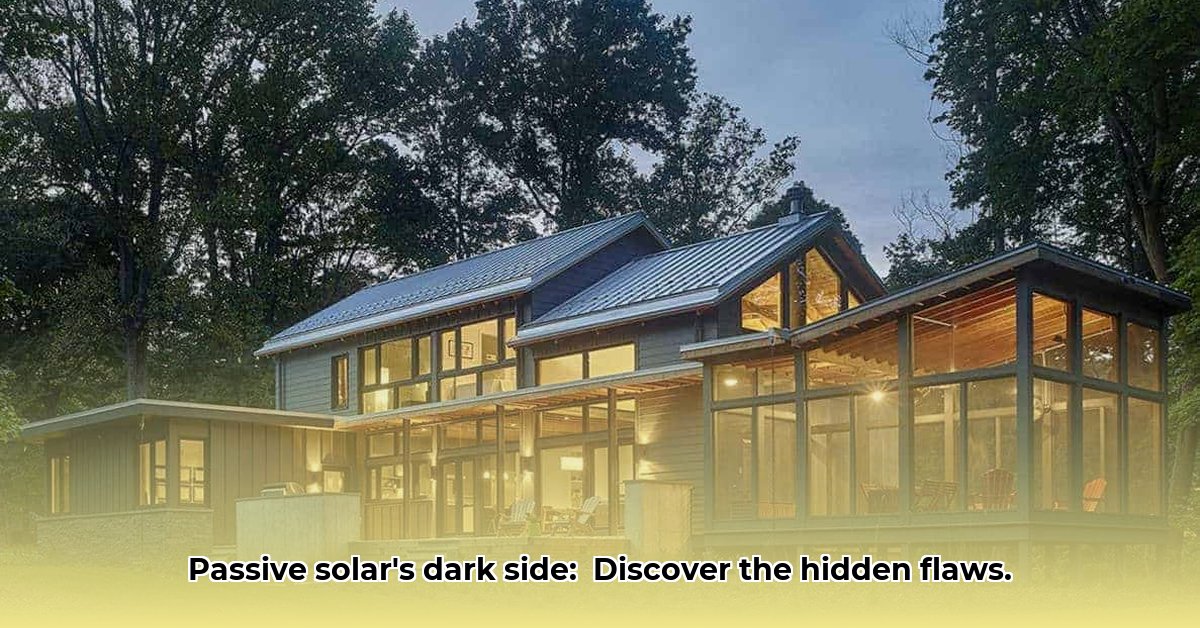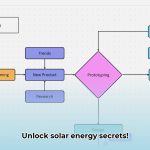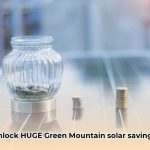Thinking about using the sun’s power to heat your home? Passive solar sounds great, right? But before you jump in, let’s talk about the downsides. While it’s eco-friendly and can save you money on energy bills, it’s not always a perfect solution. For more information on solar energy drawbacks, see this helpful resource: Solar energy downsides. This guide will walk you through the potential problems, from design flaws to higher-than-expected costs, and offer practical tips to help you make the right choice, whether you’re a homeowner, builder, or someone involved in shaping energy policies. We’ll show you how to avoid common mistakes, maintain your system effectively, and ensure your investment pays off long-term. Let’s explore the real-world challenges of passive solar energy together.
Understanding the Potential Drawbacks
Passive solar energy – a fantastic idea in theory, but like anything, it has its downsides. While it promises lower energy bills and a smaller carbon footprint, there are some important things to consider before jumping in headfirst. This guide will help you weigh the pros and cons and make an informed decision. Let’s explore some common pitfalls of solar heating and how to address them.
Initial Costs: A Significant Investment
One of the biggest hurdles is the upfront cost. Building a home designed to harness passive solar energy often means using specialized materials and techniques. This can significantly increase construction costs compared to a standard build. We’re talking about potentially thousands, even tens of thousands, more dollars. Consider specialized windows, insulation, and thermal mass materials like concrete or brick. Before you start, seriously consider if the long-term savings are worth that initial investment. It’s a significant financial commitment, influencing the overall cost of solar implementation.
- Mitigation: Explore financing options, tax credits, and rebates to offset initial expenses. Phase the project, starting with essential passive solar elements and adding more features later.
Location Matters: Sunshine is Key
Passive solar systems depend heavily on the sun. If you live somewhere cloudy or with short days, you won’t get the full benefit. In those situations, you’ll likely need supplemental heating systems (like a furnace) to keep warm, reducing the overall energy savings. Similarly, blazing summers can cause problems. Keeping your house cool might require air conditioning, eating into those hoped-for energy savings. Before you invest, really think about your location’s climate and sunlight hours, considering the impact of weather on solar power.
- Mitigation: Conduct a thorough site analysis to assess solar availability. Consider a hybrid system that combines passive solar with active solar (photovoltaic panels) or other renewable energy sources. Implement effective shading strategies during the summer months.
Design Challenges: Function vs. Aesthetics
While you can absolutely create a beautiful passive solar home, there will be some design compromises. Optimizing sunlight usually means facing your home south (in the Northern Hemisphere). This can limit where you can build or impact your window placement. To make the system work properly, you’ll usually need to use materials like concrete or brick for thermal mass (which helps store and release heat). This limits the architect’s creativity and could even lead to long construction times. It’s a bit of a balancing act between energy efficiency and architectural flair, requiring a careful evaluation of design constraints.
- Mitigation: Work with an experienced passive solar designer who can integrate energy efficiency with your aesthetic preferences. Explore innovative materials and construction techniques to achieve both thermal performance and design flexibility.
Temperature Regulation: Finding the Sweet Spot
One of the biggest challenges is keeping your home at a comfortable temperature year-round. A poorly designed system can lead to overheating in the summer and inadequate heating in the winter. The key is achieving that delicate balance. Think of it like a finely tuned instrument: getting it right requires meticulous planning and expert execution. You’ll need things like perfectly sized windows, smart shading techniques, and high-quality insulation to regulate the temperature effectively, highlighting the need for effective temperature regulation strategies. Did you know that a well-insulated home can reduce energy consumption by up to 30%?
- Mitigation: Implement smart shading strategies, such as overhangs, awnings, and strategically placed trees. Install high-performance windows with low-E coatings to minimize heat transfer. Use thermal mass effectively to moderate temperature swings.
Expertise Required: Finding the Right Professionals
Building a passive solar home requires specialized skills and knowledge. You’ll need architects, builders, and contractors who understand passive solar design principles. Finding these experts isn’t always easy, and this can lead to costly mistakes or a system that underperforms. The lack of widespread familiarity with this technology is a significant issue. This contributes to higher costs and the potential for problems down the line, emphasizing the requirement for expertise in solar home construction. Look for certifications and proven experience in passive solar design.
- Mitigation: Thoroughly vet contractors and architects. Ask for references and examples of their previous passive solar projects. Invest in educating yourself about passive solar principles to better communicate your needs and expectations.
Retrofitting Difficulties: A Complex Undertaking
Modifying an existing building to use passive solar energy is much more complex and expensive than building a new one from scratch. Adding insulation, changing windows, and installing thermal mass in an old house can require significant structural changes. It’s a big undertaking, and the cost of the retrofit could easily outweigh the energy savings you would eventually achieve. It’s worth considering if it’s even a feasible option for your existing home, given the complexities involved in retrofitting for solar efficiency.
- Mitigation: Conduct a thorough energy audit to identify the most cost-effective energy efficiency upgrades for your existing home. Focus on simpler measures, such as improving insulation and sealing air leaks, before considering more complex passive solar retrofits.
Potential for Overheating: A Balancing Act
A common issue, especially in warmer climates, is overheating. Large south-facing windows designed to capture winter sun can lead to excessive heat gain during the summer months, creating an uncomfortable indoor environment.
- Mitigation: Employ effective shading strategies, such as overhangs, awnings, and deciduous trees, to block direct sunlight during the summer. Install operable windows and vents to promote natural ventilation. Consider using light-colored roofing materials to reflect sunlight and reduce heat absorption.
Material Availability and Environmental Impact
Sourcing sustainable and environmentally friendly building materials can be challenging and costly. Some thermal mass materials, such as concrete, have a significant environmental footprint due to their production processes.
- Mitigation: Prioritize locally sourced and recycled building materials. Explore alternative thermal mass materials with lower environmental impacts, such as rammed earth or straw bales.
Aesthetics and Resale Value: Appealing to a Broad Market
While passive solar homes can be beautiful, their unique design features may not appeal to all potential buyers, potentially impacting resale value.
- Mitigation: Design your passive solar home with broad appeal in mind, incorporating popular architectural styles and features. Highlight the energy efficiency and sustainability benefits of your home to potential buyers.
Disadvantages at a Glance:
| Disadvantage | Detailed Explanation | Ways to Mitigate the Problem |
|---|---|---|
| High Initial Investment | Construction costs are considerably higher than for traditionally built homes. | Research financing options; plan carefully and choose economically sound materials; phase the project, starting with essential elements and adding more features later. |
| Climate Dependence | System effectiveness varies widely based on sunlight availability and weather conditions. | Thoroughly assess the climate; consider backup heating and cooling systems; choose wisely located homes; consider a hybrid system combining passive with active solar or other renewables. |
| Design Restrictions | Optimal solar orientation and materials can limit design flexibility. | Work with an experienced passive solar designer; explore creative compromises where feasible; prioritize both thermal performance and design flexibility. |
| Temperature Fluctuations | Maintaining comfortable temperatures year-round can be tricky without the right design. | Install high-quality insulation and use appropriate shading systems; implement smart shading strategies, such as overhangs, awnings, and trees; use thermal mass effectively to moderate temperature swings. |
| Expertise Requirement | Finding skilled professionals experienced in passive solar is essential. | Thoroughly vet contractors; invest in education about passive solar systems; ask for references and examples of previous passive solar projects. |
| Retrofit Difficulties | Adapting existing buildings for passive solar is challenging and can be very costly. | Evaluate the cost-effectiveness carefully; consider other, simpler, energy improvements first; conduct an energy audit to identify the most cost-effective upgrades. |
| Potential for Overheating | Large south-facing windows can lead to excessive heat gain during the summer. | Employ effective shading strategies; install operable windows and vents to promote natural ventilation; use light-colored roofing materials to reflect sunlight. |
| Material Availability & Impact | Sourcing sustainable materials can be challenging; some materials have a high environmental footprint. | Prioritize locally sourced and recycled building materials; explore alternative thermal mass materials with lower environmental impacts, such as rammed earth or straw bales. |
| Aesthetics & Resale Value | Unique design features may not appeal to all buyers, potentially impacting resale value. | Design with broad appeal in mind; highlight the energy efficiency and sustainability benefits of your home to potential buyers; incorporate popular architectural styles and features. |
This isn’t an exhaustive list, and each project presents its unique challenges. However, by understanding these potential drawbacks, homeowners, architects, builders, and policymakers can make more informed decisions, leading to better outcomes. Remember to do your research and consult with experts in this field. The future of passive solar is still evolving— research continues to improve its efficiency and reduce some of these challenges.
How to Compare Passive Solar Energy Costs Across Different Climates
Key Takeaways:
- Passive solar design effectiveness varies drastically depending on climate.
- Initial costs can be offset by long-term energy savings, but careful planning is crucial.
- Overheating is a common problem in warmer climates, requiring strategic design adjustments.
- Geographic location significantly impacts the feasibility and cost-effectiveness of passive solar.
- How to compare passive solar energy costs across different climates requires a thorough understanding of local climate data and building codes.
Understanding the Climate Factor
Let’s face it: sun isn’t created equal. Passive solar systems thrive in specific climates. Locations with abundant sunshine and moderate temperatures are ideal. But what about those places with extreme heat or cold? That’s where things get complicated, and how to compare passive solar energy costs across different climates becomes essential. Your location dictates design choices, potentially increasing or decreasing initial costs. For example, homes in hot, sunny Arizona require significant shading and ventilation systems, which add to upfront expenses. Conversely, a similar home in sunny but cooler California may need less extensive (and therefore less expensive) shading. Choosing the right location directly influences the viability of passive solar power.
Assessing Initial Investment
Passive solar homes often have higher upfront construction costs. Why? Specialized materials—high-performance insulation, thermal mass elements like concrete or brick—cost more than standard materials. The complexity of the design also drives up labor costs. But before you shy away, consider this: These higher initial costs are often offset by reduced energy bills over the life of the home. A detailed life-cycle cost analysis, which considers both initial costs and long-term savings, is crucial when comparing passive solar options across different climates, highlighting the need for financial planning for solar projects.
Tackling Regional Challenges
The effectiveness of passive solar varies significantly. Think of it as a finely tuned instrument; the climate is the conductor. Different climates demand diverse strategies. For example, in cold climates, maximizing solar gain is key, needing larger south-facing windows. But in hot, sunny climates, minimizing heat gain takes priority utilizing proper shading and ventilation. This means analyzing your specific climate conditions is vital when deciding how best to implement passive solar design. This careful consideration directly affects the final costs. A simple calculation of square footage of windows will not suffice when determining the true cost comparison of passive solar technologies for diverse locations, meaning climate-specific design is crucial.
Comparing Apples to Apples: A Step-by-Step Guide
To effectively compare passive solar energy costs across different climates, follow these steps:
- Climate Data Analysis: Obtain detailed local climate data (sunshine hours, temperature ranges, wind patterns, humidity) for each location you’re considering. Utilize resources like the National Oceanic and Atmospheric Administration (NOAA) for accurate information.
- Design Optimization: Consult with a passive solar expert to develop designs optimized for each climate. This step is crucial, as it directly impacts both initial and operational costs. Consider factors like building orientation, window placement, and shading strategies.
- Material Cost Comparison: Get quotes from suppliers for materials (insulation, windows, thermal mass) appropriate for each climate. Compare and contrast these costs, keeping in mind the differences in required materials. Research local building codes and regulations that may influence material choices.
- Energy Modeling: Use energy modeling software (e.g., EnergyPlus, THERM) to simulate the performance of each design, estimating energy consumption and savings. The software also assists with comparing varied climate scenarios. Calibrate the model with real-world data for increased accuracy.
- Life-Cycle Cost Analysis (LCCA): Perform an LCCA. Include initial construction costs, maintenance costs, and long-term energy savings. Factor in potential government incentives and tax credits. This comprehensive comparison provides a clear picture of the total cost of ownership over the expected lifespan of the structure.
Implementing these steps ensures a thorough cost assessment.
Don’t Forget the Fine Print: Hidden Costs and Potential Problems
Remember, there might be hidden costs. These can include additional expenses for specialized labor, permit fees that may vary regionally, and unforeseen design adjustments that may arise during construction. Carefully consider all possible aspects before making final decisions about the implementation of passive solar technologies, paying attention to unexpected solar expenses. Also, factor in potential maintenance costs and replacement costs for components like windows and shading devices.
Case Study Examples:
- Example 1: Cold Climate (Minnesota): Higher insulation levels, triple-pane windows, and a focus on maximizing solar gain are essential. Initial costs will be higher, but long-term heating savings will be significant.
- Example 2: Hot, Arid Climate (Arizona): Shading devices, natural ventilation, and light-colored building materials are crucial to minimize heat gain. Cooling costs will be lower, but careful design is needed to prevent overheating.
- Example 3: Temperate Climate (California): A balanced approach that incorporates both heating and cooling strategies is needed. The moderate climate allows for greater design flexibility.
The Bottom Line
While passive solar offers attractive long-term benefits, its feasibility and cost-effectiveness are deeply tied to the climate. A thorough comparison, performed by a qualified professional, is essential. This comparison requires careful analysis of energy modeling, climate data, and consideration of potential problems. Therefore, a comprehensive approach to cost comparison across various climates ensures a sound investment while maximizing the return on your energy investment.
Consumer Energy Center
Passive Solar System Maintenance for Optimal Energy Savings
Key Takeaways:
- Passive solar design, while offering significant long-term energy savings and environmental benefits, presents certain limitations.
- Understanding these limitations is crucial for maximizing energy efficiency and minimizing potential drawbacks.
- Proper maintenance is key to ensuring the longevity and optimal performance of your passive solar system.
- Climate considerations significantly impact the effectiveness of passive solar systems.
- High initial costs and design complexity are noteworthy drawbacks.
Understanding the Limitations of Passive Solar Systems
Let’s be realistic: passive solar isn’t a magic bullet. While it offers substantial long-term advantages, it’s not without its challenges. Think of it as a finely tuned instrument; it needs proper care and understanding to perform at its best. One significant limitation is its climate dependency. Systems work best in locations with ample sunshine and moderate climates. In areas with harsh winters or insufficient sunlight, their effectiveness diminishes. This is why thorough site analysis is crucial before implementation, emphasizing the need for optimal conditions.
Another factor is the initial cost. While long-term savings are considerable, the upfront investment can be higher than conventional building methods. You’re investing in specialized materials, design expertise, and potentially complex constructions. Is the long-term return worth the initial expense? That’s a financial calculation each homeowner must make, requiring careful financial evaluation.
Design Complexity and the Importance of Expertise
Passive solar design isn’t simply about placing windows strategically. It requires a deep understanding of building science, including thermal mass, natural ventilation, and shading. Designing a truly effective passive solar system necessitates skilled professionals who can balance energy efficiency, comfort, and aesthetic considerations. Retrofitting existing buildings is often even more complex and expensive than constructing new ones, underscoring the demands for specialized expertise.
Passive Solar System Maintenance for Optimal Energy Savings: A Practical Guide
Regular maintenance is fundamental to ensuring the continued efficiency of your passive solar system and achieving those promised energy savings. Neglecting maintenance can lead to diminished performance and even costly repairs down the line. Let’s explore a few key aspects:
- Window Cleaning: Clean windows are vital for maximizing sunlight penetration. Regular cleaning, at least twice a year, is recommended. Consider using eco-friendly cleaning products. Use a soft cloth and mild detergent to avoid scratching the glass.
- Shading Device Inspection: Inspect overhangs, awnings, and other shading devices for damage or wear. Repair or replace them promptly to maintain their effectiveness in regulating interior temperatures. Check for proper alignment and functionality.
- Ventilation System Checks: If your passive solar design incorporates natural ventilation systems, ensure they function correctly. Clean vents and ducts regularly, and check for any obstructions or leaks. Consider installing air filters to improve indoor air quality.
- Thermal Mass Monitoring: For systems that rely on thermal mass, monitor their performance. Ensure proper insulation to minimize heat loss in the winter and heat gain in the summer. Visually inspect thermal mass surfaces for cracks or damage.
- Landscaping Maintenance: Trim trees and shrubs to prevent them from blocking sunlight during the winter months. Ensure that vegetation does not obstruct ventilation pathways.
- Sealant and Weather Stripping Inspection: Check window and door sealants and weather stripping for deterioration. Replace as needed to prevent air leaks.
- Regular Inspections: Conduct annual inspections by a qualified professional. They can identify potential problems before they escalate into major issues, ensuring long-term system health.
Additional Maintenance Tips:
- Monitor Energy Bills: Track your energy consumption to identify any unexpected changes in performance.
- Keep Records: Maintain records of all maintenance activities and repairs.
- Consult Professionals: Don’t hesitate to consult with qualified professionals for any maintenance or repair needs.
Weighing the Pros and Cons
| Pros | Cons |
|---|---|
| Significant long-term energy cost savings | High initial costs |
| Reduced environmental impact | Climate dependency |
| Enhanced comfort | Design complexity requiring expert knowledge |
| Improved air quality | Difficulty retrofitting existing buildings |
By understanding these limitations and diligently performing the recommended passive solar system maintenance for optimal energy savings, prospective homeowners and developers can make informed decisions and reap the substantial benefits of passive solar technology.
https://www.luxwisp.com/pros-and-cons-of-passive-solar-energy/
Comparing Passive Solar Systems Across Diverse Climates
Key Takeaways:
- Passive solar heating offers significant energy savings and reduced carbon emissions but its effectiveness varies greatly depending on location and climate.
- Existing prediction models have limitations, especially in regions with moderate temperature differences between indoor and outdoor environments.
- Careful consideration of factors like building orientation, materials, and design is crucial for successful passive solar implementation.
- Initial costs can be high, and retrofitting existing buildings presents unique challenges.
Climate Suitability: The Biggest Hurdle
Let’s face it: passive solar design isn’t a one-size-fits-all solution. Comparing passive solar systems across diverse climates reveals a stark reality: what works wonders in sunny Arizona might utterly fail in cloudy Seattle. Sunlight is the lifeblood of passive solar heating. Insufficient solar radiation renders the system ineffective, regardless of its clever design. Think of it like trying to grow tomatoes in Alaska – you might get a few, but not a bountiful harvest, illustrating the importance of climate compatibility. The amount of solar radiation varies significantly based on latitude, altitude, and cloud cover.
Mastering the Design: More Than Meets the Eye
Even in ideal climates, success hinges on meticulous design. Proper orientation is paramount – maximizing winter sun exposure while minimizing summer heat gain. This requires understanding your local climate and its nuances. Material selection is equally critical. High thermal mass materials (like concrete or brick) store and release heat slowly, evening out temperature fluctuations. But choosing the wrong materials can lead to overheating or significant heat loss. Careful planning ensures optimized solar design. Consider factors like window placement, overhangs, and insulation levels.
The Cost Conundrum: Weighing Investment vs. Savings
We often hear about the long-term cost savings of passive solar. But, let’s be realistic; upfront costs can be substantial. This is particularly true for new constructions incorporating sophisticated features. Retrofitting existing buildings usually involves even higher expenses. The financial commitment demands careful consideration and a thorough cost-benefit analysis, encompassing potential energy savings, maintenance costs, and your timeline. Will the long-term energy savings justify the initial investment? Are financing options readily accessible? These are questions that need clear answers before you begin, necessitating thorough financial analysis.
The Urban Challenge: Navigating the Heat Island Effect
Cities are notoriously hotter than surrounding rural areas – the urban heat island effect. This complicates passive solar design. Buildings absorb and radiate heat, further increasing temperatures. This means that you may need additional strategies to manage heat, potentially negating some of the efficiency gains, highlighting the impact of urban environments. The urban heat island effect can increase average city temperatures by 1-3°C (1.8-5.4°F) compared to rural areas. Consider strategies like green roofs and reflective surfaces to mitigate the heat island effect.
Modeling Software Limitations:
Existing prediction models often struggle to accurately simulate the performance of passive solar systems in regions with moderate temperature differences between indoor and outdoor environments. Further research is needed to improve the accuracy of these models.
Overcoming Challenges: Steps to Success
- Step 1: Thorough Site Analysis: Start by assessing sun angles, prevailing winds, and local climate data. Use tools like a sun path diagram to visualize solar availability throughout the year.
- Step 2: Expert Consultation: Consult with experienced architects, engineers, and builders specializing in passive solar design. Seek out professionals with a proven track record in your specific climate.
- Step 3: Realistic Expectations: Understand the limitations of passive solar in your specific climate and adjust expectations accordingly. Don’t expect a passive solar system to completely eliminate the need for supplemental heating or cooling.
- Step 4: Energy Modeling: Use energy modeling software to simulate the performance of different passive solar designs before finalizing your choice, facilitating successful solar implementation. Calibrate the model with real-world data to improve accuracy.
- Step 5: Consider Passive Cooling Strategies: In warmer climates, focus on passive cooling strategies such as natural ventilation, shading, and evaporative cooling.
A Realistic Perspective: Weighing the Pros and Cons
| Feature | Pros | Cons |
|---|---|---|
| Energy Savings | Significant reduction in heating costs, lower carbon footprint | Limited effectiveness in climates with insufficient sunlight or extreme temperatures |
| Cost | Long-term cost savings, reduced reliance on fossil fuels | High upfront costs, especially for renovations or complex designs |
| Maintenance | Low maintenance requirements | Proper design and construction crucial to ensure long-term performance |
| Environment | Environmentally friendly, reduces greenhouse gas emissions | Effectiveness depends heavily on climate and design; can be energy intensive in some conditions |
| Design Impact | Can enhance natural lighting and create comfortable indoor spaces | Design limitations can restrict architectural flexibility |
- Wind Energy Powered Cars: Are They the Future of Driving? - December 3, 2025
- Wind Energy in Cars: Is This the Future? - November 30, 2025
- Wind Energy For Residential: Is It Right For Your Home? - November 28, 2025
















